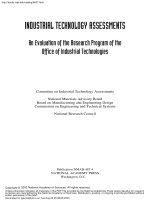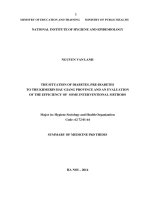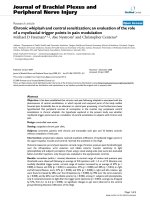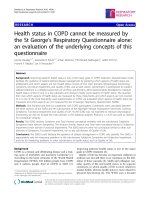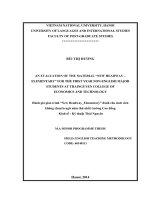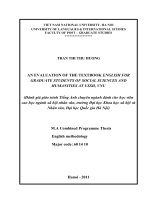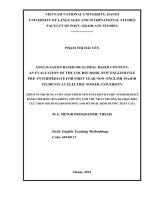An evaluation of the listening component in the textbook new headway elementary to teach listening skills for non major english college freshmen at hanoi university of industry
Bạn đang xem bản rút gọn của tài liệu. Xem và tải ngay bản đầy đủ của tài liệu tại đây (1.47 MB, 78 trang )
VIETNAM NATIONAL UNIVERSITY, HANOI
UNIVERSITY OF LANGUAGES AND INTERNATIONAL STUDIES
FACULTY OF POST – GRADUATE STUDIES
*********************
TRẦN THỊ THANH XUÂN
AN EVALUATION OF THE LISTENING COMPONENT IN THE
TEXTBOOK NEW HEADWAY ELEMENTARY TO TEACH LISTENING
SKILLS FOR NON-MAFOR ENGLISH COLLEGE FRESHMEN
AT HANOI UNIVERSITY OF INDUSTRY
(Đánh giá phần nghe trong cuốn giáo trình New Headway Elementary
để dạy kĩ năng nghe cho sinh viên cao đẳng không chuyên Tiếng Anh
tại trường Đại học Công nghiệp Hà Nội)
M.A. MINOR PROGRAMME THESIS
Field : English Teaching Methodology
Code : 60.14.01.11
Hanoi - 2014
VIETNAM NATIONAL UNIVERSITY, HANOI
UNIVERSITY OF LANGUAGES AND INTERNATIONAL STUDIES
FACULTY OF POST – GRADUATE STUDIES
*********************
TRẦN THỊ THANH XUÂN
AN EVALUATION OF THE LISTENING COMPONENT IN THE
TEXTBOOK NEW HEADWAY ELEMENTARY TO TEACH LISTENING
SKILLS FOR NON-MAFOR ENGLISH COLLEGE FRESHMEN
AT HANOI UNIVERSITY OF INDUSTRY
(Đánh giá phần nghe trong cuốn giáo trình New Headway Elementary
để dạy kĩ năng nghe cho sinh viên cao đẳng không chuyên Tiếng Anh
tại trường Đại học Công nghiệp Hà Nội)
M.A. MINOR PROGRAMME THESIS
Field
: English Teaching Methodology
Code
: 60.14.01.11
Supervisor: Dương Thu Mai, PhD
Hanoi - 2014
DECLARATION
I hereby declare that this thesis is my own work and effort and that it has not
been submitted to any other university or institution wholly or partially.
Hanoi, July 2014
Trần Thị Thanh Xuân
i
ACKNOWLEDGEMENTS
First and foremost, I am deeply indebted to my supervisor, Ms. Duong
Thu Mai, PhD from Vietnam National University, University of Languages and
International Studies, for her precious advice, academic guidance and support.
Without her invaluable assistance, this thesis would not have been fulfilled.
I would also like to express my sincere thanks to all lecturers and the staff
of the Faculty of Post Graduate Studies, University of Languages and
International Studies, Vietnam National University for their useful lessons and
materials which are of great values to my thesis.
I am appreciative of all my colleagues, and the non- major English college
freshmen at Hanoi University of Industry for their precious cooperation in giving
valuable information.
Last but not least, I find myself in debt to my dear family, and my friends
who are always supporting me with their considerations and encouragement.
ii
ABSTRACT
This study was conducted to obtain knowledge about the evaluation of the
textbook New Headway Elementary used for non- major English college freshmen
at Hanoi University of Industry (HaUI) from the perspectives of the users of the
material (i.e. non- major English college freshmen and their listening teachers). It
took into consideration the listening needs of the target students in order to suggest
changes for the improvements for teaching listening skill to non- major English
college freshmen at HaUI.
The participants included 110 students chosen randomly among non- major
English college freshmen at HaUI and 22 teachers who were in charge of teaching
English for non- major English college freshmen. Two survey questionnaires were
employed to discover the participants‟ perspectives of the students‟ listening needs
and how the materials met these needs. Both quantitative and qualitative methods
were used to analyse data obtained from the aforementioned data collection
instruments. Quantitative data were processed using Statistical Package for the
Social Sciences (SPSS).
The findings of the research provided insight into the listening needs of nonmajor English college freshmen at HaUI as well as how the textbook New Headway
Elementary was evaluated in the students and teachers‟ viewpoints. It can be clearly
seen from the results of the study that listening to English was a challenge to the
students. Hence, they needed support in various forms such as facilities, materials,
teachers‟ guidance, etc in order to improve their listening skill. The results were
generally in favour of the textbook. However, there was a need to improve some
elements of the book such as language input, post- listening and pair or group
activities, active listening periods, visual materials, etc. to better meet the Ss‟ needs.
Based on the findings of the study, some recommendations for the materials being
evaluated and other elements of the listening course were suggested.
iii
LIST OF ABBREVIATIONS
EFL
: English as a foreign language
ESL
: English as a second language
ESP
: English for specific purposes
FCE
: First Certificate in English
HaUI
: Hanoi University of Industry
MA
: Master of Arts
NA
: Needs analysis
SPSS
: Statistical Package for the Social Sciences
Ss
: Students
Ts
: Teachers
iv
LIST OF TABLES AND FIGURES
Figure 1.1: Comparison different criteria for materials evaluation
Figure 3.1: Ss‟ needs in the aim of listening in a course
Figure 3.2: Ss‟ in lessons and kowledge of the lessons
Figure 3.3: Ss‟ needs in three stages of listening
Figure 3.4: Ss‟ needs in activities
Figure 3.5: Ss‟ needs in topics
Figure 3.6: Ss‟ needs in methods
Figure 3.7: Ss‟ needs at the end of a course
Figure 3.8: Ss‟ needs in layout and practical concerns
Table 3.1: Ss and Ts‟ overall judgment on textbook‟s aim in terms of listening
Table 3.2: Ss and Ts‟ overall judgment on lessons and knowledge of students
Table 3.3: Ss and Ts‟ overall judgment on listening
Table 3.4: Ss and Ts‟ overall judgment on topics in listening
Table 3.5: Ss and Ts‟ overall judgment on method used for listening periods
Table 3. 6: Ss and Ts‟ overall judgment on assessment after the course
Table 3.7: Ss and Ts‟ overall judgment on layout and practical concerns
v
TABLE OF CONTENTS
DECLARATION ........................................................................................................ i
ACKNOWLEDGEMENTS ....................................................................................... ii
ABSTRACT .............................................................................................................. iii
LIST OF ABBREVIATIONS ................................................................................... iv
LIST OF TABLES AND FIGURES ...........................................................................v
PART I. INTRODUCTION ........................................................................................1
1. Rationale for the thesis .........................................................................................1
2. Aims of the study ....................................................................................................2
3. Scope of the study ...................................................................................................2
4. Significance of the study .........................................................................................2
6. Design of the study..................................................................................................3
PART II: DEVELOPMENT .......................................................................................4
CHAPTER 1: LITERATURE REVIEW ....................................................................4
1.1. Materials in language teaching and learning........................................................4
1.1.1. Definitions and Classifications of materials .....................................................4
1.1.2. Roles of materials in language teaching and learning.......................................4
1.2. Materials Evaluation ............................................................................................5
1.2.1. Definitions of materials evaluation ...................................................................5
1.2.2. Materials evaluation in English language teaching and learning ......................6
1.2.3. Criteria for materials evaluation .......................................................................6
1.3. Listening comprehension and teaching listening comprehension .......................8
1.3.1. Definition of listening comprehension ..............................................................8
1.3.2. Communicative competence in teaching listening comprehension ..................9
1.3.3. Three stages of listening sessions ...................................................................11
1.3.4. Methods of teaching listening communicatively ............................................12
1.3.5.Potential problems in learning listening comprehension .................................13
1.4. Needs analysis (NA) in language teaching ........................................................14
vi
CHAPTER 2: METHODOLOGY ............................................................................16
2.1. Current situation of teaching and learning English listening at Hanoi University
of Industry. ................................................................................................................16
2.1.1. The context of the study ..................................................................................16
2.1.2. The material description ..................................................................................17
2.2. The study ............................................................................................................17
2.2.1. Research questions ..........................................................................................17
2.2.2. Participants of the study ..................................................................................18
2.2.3. Data collection instrument ..............................................................................18
2.2.4. Methods of data analysis .................................................................................20
CHAPTER 3: FINDINGS AND DISCUSSIONS ...................................................21
3.1. Students‟ listening needs ....................................................................................21
3.1.1. Students‟ needs in the aim of listening in a course .........................................21
3.1.2. Students‟ needs in term of lesson and knowledge ..........................................21
3.1.3. Students‟ needs in activities ............................................................................22
3.1.4. Students‟ needs in topics .................................................................................25
3.1.5. Students‟ needs in methods .............................................................................26
3.1.6. Students needs at the end of a course ..............................................................27
3.1.7. Students‟ needs in layout and practical concerns............................................28
3.2. Evaluation of the textbook New Headway Elementary for non –major freshmen
at HaUI as perceived by the Ss and Ts ......................................................................29
3.2.1. Evaluation of the textbook in terms of aim of listening ..................................29
3.2.2. Evaluation of the textbook in terms of lessons and knowledge ......................30
3.2.3. Evaluation of the textbook in terms of listening activities .............................31
3.2.4. Evaluation of the textbook in terms of topics .................................................34
3.2.5. Evaluation of the textbook in terms of methods used in listening periods. ....34
3.2.6. Evaluation of the textbook in terms of the student assessment ......................36
3.2.7. Evaluation of the textbook in terms of layout and grammatical concerns ......36
3.3. Interview findings ..............................................................................................38
3.3.1 Students‟ needs to improve their listening skills .............................................38
vii
3.3.2. Students‟ opinions on the book‟ changes in order to better meet their needs.39
3.4. Discussion of findings ........................................................................................39
3.4.1. Students‟ needs analysis ..................................................................................39
3.4.2. Evaluation of the textbook New Headway Elementary for non –major
freshmen at HaUI as perceived by the Ss and Ts ......................................................40
PART III: CONCLUSION ........................................................................................42
1. Conclusion of the study.........................................................................................42
2. Recommendations for material improvements .....................................................42
3. Limitations and suggestions for further studies ....................................................43
REFERENCES ..........................................................................................................45
APEENDIX ................................................................................................................. I
viii
PART I. INTRODUCTION
1. Rationale for the thesis
Listening comprehension plays a key role in language learning. Rost (1994,
as cited in Nunan & Miller, 1995) confirms that listening is vital in language
classrooms because it provides input for learners. Without understanding inputs at
the right level, any kind of learning simply cannot occur. Listening, therefore, is
essential not only as a receptive skill but also to the development of spoken
language proficiency.
An important issue in the teaching and learning of listening is the material.
Hutchinson and Torres (1994: 3) state that the material is “an almost universal
element of English language teaching and learning”. Tomlinson (2003: 2) also
asserts that material “include anything which can be used to facilitate the learning of
a language.”
Among available material, careful consideration is needed in order to
evaluate and choose the best materials. The importance role of material evaluation
has been recognised by many researchers and experts in foreign language teaching
such as Ellis (1997) and Robinson (1991), who claim that material evaluation
should be carried out not only to choose the most suitable for one‟s particular
situation but also to determine whether the chosen ones work for that situation after
having been used for a period of time. It can also bring general insights into how
teachers use materials and suggest directions both for materials development and
professional development activities (Hutchinson & Torres, 1994).
At Hanoi University of Industry (HaUI), listening skills have been taught for
non-major English college freshmen based on the textbook New Headway
Elementary (the third edition by Liz and John Soar) for a long time. From the
researcher‟s observation and professional experience as a teacher of English,
teaching and learning listening skills have still faced some difficulties and the
students‟ ability to listen English has not improved much. However, no research has
been done to evaluate the listening skill section in New Headway Elementary.
1
Therefore, an evaluation of listening skills in the textbook New Headway
Elementary from teachers and students‟ perspectives was carried out with an
expectation that a solution for the situation of teaching and learning listening skills
at HaUI with the textbook New Headway Elementary will be found.
2. Aims of the study
New Headway textbook is used for first year students during two semesters
or twenty weeks. Each unit is instructed in nine or ten periods of teaching and
learning. The listening component is studied in one or two periods. The research
aims to both evaluate the usefulness of the book and determine whether the
textbook is suitable for teaching listening in the limited time. More specifically, this
study seeks to examine the following research questions.
1. What are the non- major English college freshmen‟s needs when learning
listening skills at HaUI?
2. To what extent does the current listening in-class component in New
Headway Elementary meet their needs at HaUI?
3. Scope of the study
Due to the small scale of the study as well as the limitation of time, this study
only focuses on evaluating the current listening component in the New Headway
Elementary for non- major English college freshmen at HaUI from the perspectives
of the users of these materials (e.g. the students and teachers taking part in teaching
and learning with the New Headway Elementary in school year 2013-2014. The
other components such as speaking, reading and writing are not within the scope of
this study.
4. Significance of the study
The findings of the thesis may serve as useful information not only for the
researcher, the course book designers but also for the teaching staff and the nonmajor English college freshmen at HaUI. It is also hoped that the thesis will make
great contributions towards the development of the listening materials at HaUI.
2
5. Method of the study
To achieve the aims stated, both quantitative and qualitative methods were
used. The data collected for the study come from two survey questionnaires (of 110
non- major English college freshmen at HaUI who have just finished studying New
Headway Elementary ,and 22 teachers who have taught non- major English college
freshmen using the textbook) and interviews from 10 random ones among 110
students
6. Design of the study
Part I: Introduction includes the rationale, aims, scope, significance and
methodology of the study
Part II: Development
Chapter 1: Literature review presents literature related to the study including
material and material evaluation such as definitions and classifications of materials
and materials evaluation, and criteria for materials evaluation. Theoretical
backgrounds to listening and teaching listening includes definition of listening
comprehesion, approaches to the teaching of listening skills, methods of teaching
listening communicatively, and potential diffificulties in listening. The last part is
need analysis in language teaching and learning.
Chapter 2: Methodology shows the procedure for carrying on the research
such as selection of sample, instruments for data gathering, and methods of data
analysis.
Chapter 3: Findings and Discussion report the main findings obtained from
the data collection and discuss the prominent aspects.
Part III: Conclusion, which is the last chapter, followed by references is the
summary of the whole study. The limitation of the study and suggestion for further
study are also recommended.
3
PART II: DEVELOPMENT
CHAPTER 1: LITERATURE REVIEW
1.1. Materials in language teaching and learning
1.1.1. Definitions and Classifications of materials
According to Tomlinson (1998), materials will be considered anything
which is used to help language learning. Examples include: coursebooks,
workbooks, CDs, flashcards, and CD-ROMs.
Richard (2001) states that materials can be instructional, experiential,
elucidative, and exploratory but they must provide experience of the language in use
and help learners to make discoveries about the language.
According to McGrath (2002), materials include those that have been either
specifically designed for learning and teaching language (e.g. textbooks,
worksheets, computer software); authentic materials ( e.g. off-air recordings,
newspaper articles) that have been specially selected and exploited for teaching
purposes by the classroom teacher; teacher-written materials; and learner-generated
materials. However, in the local setting, textbook seem to be most widely used
material in the language program.
As being a kind of materials, the textbook New Headway Elementary is used
in this study for evaluation of teaching and learning listening skills at HaUI.
1.1.2. Roles of materials in language teaching and learning
In the English as a Second Language (ESL) classroom, materials are an
important aspect of the curriculum. They are the most observable feature of a
teacher‟s methodology, and can contribute greatly to a course‟s syllabus (White,
1988)
Stressing on the role of materials, Richards (2001) points out that materials
can serve as the basis for much of the language input that the learners receive and as
the source for much of the language practice that occurs in the classroom. Richards
(2001) further explains that materials provide basis for the content of the lesson, the
balance of skills taught, and the kind of language practice students take part in. In
4
addition, good materials are of great help to inexperienced teachers and poorly
trained teachers (Nunan, 1991). They can serve as “a form of teacher training”
(Richard, 2001: 251) and teachers can get ideas on how to plan and teach the lesson
from the materials.
According to Bell and Gower (1998, as cited in Rubdy 2003: 39), materials
“provide teachers and learners with a range of professionally developed materials
within tried and tested syllabus structures”, allowing teachers to spend their
valuable time on facilitating learning than materials production. Materials can be
adapted and supplemented to meet the needs of specific classes.
Obviously, according to all the authors above, materials are a key and crucial
component in any language teaching and learning contexts, the teacher needs to take
account of the roles as well as the requirements of materials when designing or
selecting materials for his/ her own teaching situation to facilitate the most learning
from the students.
1.2. Materials Evaluation
1.2.1. Definitions of materials evaluation
According to Brown (1995), evaluation is the systematic collection and
analysis of all relevant information necessary to promote the improvement of a
curriculum and assess its effectiveness within the context of the particular
institution involved. It is understood that information be gathered and analyzed in a
systematic manner and that only relevant information should be included, that is
other information can be ignored.
Nunan (1988) states that evaluation be “a process not a final product” that
means it takes place at any time of the material design. It is essential to determine
whether the goals and objectives of a language program are being attained.
Hutchinson and Waters (1987) present that evaluation is really a matter of
judging the fitness of something for a particular purpose. “Given a certain need, and
in the light of the resources available, which out of number of possibilities can
5
represent the best solution? There is no absolute good or bad- only degrees of
fitness for the required purpose”.
In sum, it can be concluded that materials evaluation involves the
determination of what needs to be evaluated, the objectives and requirements for the
materials, and the judgments of the value of the materials being evaluated in
relation to the objectives and requirements determined.
1.2.2. Materials evaluation in English language teaching and learning
Ellis (1997) gives two main reasons for carrying out materials evaluation.
The first reason is that there are too many materials available to choose, and it is
needed to get the most suitable one. The second one relates to a need for materials
evaluation to determine whether the material which has been chosen works for that
situation after it has been used for a period of time
Robinson (1991) adds that evaluation can be used as part of quality control.
The advantages and disadvantages as well as the effectiveness of the being used
materials can be seen by evaluating. Therefore, the decision choosing materials for
language teaching and learning can be reused or it needs to be adapted to meet the
need of the particular teaching situation or needs to be changed absolutely.
In short, materials evaluation will provide the input for responsible people to
evaluate the effectiveness of the materials.
1.2.3. Criteria for materials evaluation
Criteria are what evaluators use to “reach a decision regarding what needs to
be evaluated” (Tomlinson, 1998: 220). Before evaluating materials, evaluators must
know the definition of criteria. Criteria for materials evaluation depend on what is
being evaluated and why they need to be evaluated (Dudley – Evans and St. John,
1998).
Ur (1996 ) presents a
list of several criteria composed of nineteen
features.These features include: objectives
being explicitly laid out in an
introduction and implemented in the material, approach educationally and socially
to the target community, clear attractive layout and easy print to read, appropriate
6
visual materials available, interesting topics and tasks, varied topics and tasks, clear
instructions, systematic coverage of syllabus, clearly organized and graded content,
periodic review and test sections, plenty of authentic language, good pronunciation,
vocabulary and grammar explanation and practice, fluency practice in all four skills,
encouraging learners to develop their own learning strategies and to become
independent, adequate guidance for teacher; audio cassettes, and being readily
available locally.
Zabawa (2001) suggests a checklist of criteria for the Cambridge First
Certificate in English (FCE) textbooks that he argues will work for all EFL
textbook. This checklist considers 10 categories: layout and design, material
organization, language proficiency, teaching reading comprehension, teaching
writing, teaching grammar and vocabulary, teaching listening comprehension,
teaching oral skills, content, and exam practice
Cunningsworth (2002) states a model of coursebook evaluation which
contains 45 criteria in different domains such as the aims, design, language content,
skills, and methodology. He provided easy and useful cousebook evaluation
checklists to assist people to have ideas how to evaluate coursebook and also
provide great demonstrations for this reasearch.
Harmer (1998) states that there are nine main areas which teachers should
consider in the books they evaluate: price, availability, layout and design,
methodology, skills, syllabus, topic, stereotyping, and the teacher‟s guide
The similarities in the above well-known authors‟ criteria for material evaluation
can be summarized in the following table:
Criteria
Ur
Zabawa
Cunningsworth Harmer
(1996 )
(2001)
(2002)
Objectives
√
Target community
√
√
Layout/ design
√
√
Topics and tasks
√
(1998)
√
√
√
√
7
Instructions
√
Syllabus
√
Content
√
Visual materials
√
Authentic language
√
Test/ exam practice
√
Pronunciation
√
Method
√
Guidance for teacher
√
√
Audio/ cassettes
√
√
√
√
√
√
√
Price
√
√
Skills
√
Availability
√
√
√
√
Figure 1.1: Comparison different criteria for materials evaluation
From the table, it can be seen that several criteria stand out, including aim,
lesson/ knowledge, activities, method, assessment, and layout and practical
concerns. These will be used in this study and will be more clearly presented in the
chapter of methodology.
1.3. Listening comprehension and teaching listening comprehension
1.3.1. Definition of listening comprehension
Listening comprehension is more than obtaining meaning from utterance. It
also involves a process in which students match utterance with what they already
know about the topic. When knowing the concept or the topic, they can activate
their prior knowledge to get something from that knowledge which is needed for
comprehending the message. Brown (2001: 2) states “One very important idea for
teaching listening is that listening courses must make use of student‟s prior
knowledge in order to improve listening comprehension”.
According to Buck (2001: 31), listening comprehension is an active process
of constructing meaning and this is done by “applying knowledge to the incoming
8
sounds” in which “number of different types of knowledge are involved: both
linguistic knowledge and non-linguistic knowledge”.
Vandergrift (1999: 168) states that “listening comprehension is an active
process in which the listener must discriminate between sounds, understand
vocabulary and grammatical structures, interpret stress and intonation, retain what
was gathered in all the above and interpret it with the immediate as well as the
larger context of the utterances”
To sum up, there are two points to note. One of these is that listening is an
active, conscious and complex process and the other characteristics is that listening
is the interpretation of what listeners hear. It matches with what they already know
to comprehend the messages taken in. The next one is that listeners do not receive
information passively but applied and moderated their background knowledge to
assist the understanding of input actively. Therefore, in the current study, the term
“listening” would be treated the same as the term “listening comprehension”
due to its learners‟ ultimate goal of listening is to comprehend what they hear as
defined in this part.
1.3.2. Communicative competence in teaching listening comprehension
English language teaching profession has changed tremendously in the light
of Communicative Language Teaching approach. In order to use English
effectively, learners need to develop communicative competence. Therefore, it is
important to teach listening skills in communicative approaches. Canale and Swain
(1980) and further developed by Canale (1983) provide the basis of the
communicative competence by including a variety of competences, more
precisely
those
of
strategic
competence;
grammatical
and
competence;
discourse
sociolinguistic competence;
competence.
The grammatical
competence refers to the linguistic features of language which involves
lexicon, pronunciation, spelling, word formation and sentence structure. The
sociolinguistic competence is related to the sociocultural conditions that can affect
participants‟ language use. The strategic competence involves a set of
9
strategies which may be used to solve any problem caused during the
communicative event. Finally, the discourse competence is understood as the
ability to produce and interpret coherent and cohesive spoken or written texts
beyond the level of the sentence.
In addition to this, Bachman and Palmer‟s model (1996) proposes a
communicative model which consists of organisational knowledge and pragmatic
knowledge. Organisational knowledge is composed of abilities which engage in a
control over formal language structures, i.e. of grammatical and textual knowledge.
Grammatical knowledge includes several rather independent areas of knowledge
such as knowledge of vocabulary, morphology, syntax, phonology, and graphology.
Textual knowledge enables comprehension and production of (spoken or written)
texts. It covers the knowledge of conventions for combining sentences or utterances
into texts. Pragmatic knowledge refers to abilities for creating and interpreting
discourse. Two areas of knowledge are contained: knowledge of pragmatic
conventions for expressing acceptable language functions and for interpreting the
illocutionary power of utterances or discourse (functional knowledge) and
knowledge of sociolinguistic conventions for creating and interpreting language
utterances which are appropriate in a particular context of language use
(sociolinguistic knowledge). Strategic knowledge is conceived in the model as a set
of metacognitive components which enable language user involvement in goal
setting, assessment of communicative sources, and planning.
It can be seen from models of Canale and Swain (1980), Canale (1983), and
Bachman and Palmer (1996) that Bachman and Palmer‟s model is more complex,
more comprehensive and much clearer than the model of Canale and Swain. It is
preferable because of its detailed and at the same time very organisational
description of basic components of communicative competence.
Beside the knowledge of language competences discussed above, English
teaching methodology of teachers are greatly contributed, which entails different
approaches, methods of language teaching and learning, activities and learning
10
styles, and the material. This is to make sure that they can connect to evaluate the
textbook New Headway Elementary for teaching listening skills.
1.3.3. Three stages of listening sessions
There are often three main stages in a listening session. They are: prelistening stage, while-listening stage, and post-listening stage. Each stage has its
own aims and activities
Pre-listening stage
Pre-listening stage prepares student by getting them to think about the topic
or situation before they listen to the texts. In other words, it gives students a purpose
to listen. It also gets students to relate to what they already know about the topic and
arouses their interest in listening. During pre-listening the teacher may
assess students' background knowledge of the topic and linguistic content of
the text
provide students with the background knowledge necessary for their
comprehension of the listening passage or activate the existing knowledge that the
students possess
make students aware of the type of text they will be listening to, the role they
will play, and the purpose(s) for which they will be listening
provide opportunities for group or collaborative work and for background
reading or class discussion activities
While-listening stage
The while-listening stage involves activities that students are asked to do
during the time that they are listening to the text. This stage gives students a guide
of framework to practice listening. It helps students to listen better, more accurately
through carefully designed comprehension tasks. Good while-listening activities
help learners find the way through the listening text and build upon the expectation
raised by pre-listening activities.
Post-listening stage
11
Post-listening stage involves activities related to a particular listening text
(whether recorded or spoken by the teacher) which are done after the listening is
completed.
The purposes of post-listening activities are:
To check whether the learners have understood what they need to or not.
To see why some students have missed parts of message.
To give the students the opportunity to consider the attitude and manner of
the speaker of the listening text.
To expand on the topic or language of the message and to transfer learned
things to another context.
To make introduction for the planned work.
1.3.4. Methods of teaching listening communicatively
Brown( 2001), Mangubhai ( 2002) state methods of teaching listening
comprehension include:
a)
Motivating students to focus on the learning objectives
Understanding the purpose of a particular listening comprehension activity clearly,
students may focus on essential vocabulary and grammar and listen for specific
information. This will motivate them to doing activities more effectively
b)
Applying appropriate teaching methods and techniques
It is important that teachers should apply the following methods and techniques
to make the lessons challenging, effective, and interesting to the students.
Use a variety of activities
If a teacher always uses the same activities, they will become boring for
students. It is necessary to vary activities to stimulate the students‟ interest and
challenge them with something new. It is also important to consider activities that
involve group work and problem solving and that instigate communication and
listening comprehension development.
12
1.3.5.Potential problems in learning listening comprehension
Underwood (1989) presents seven problems which learners often encounter
in learning listening. Firstly, it is difficult for them to catch speakers‟ speed.
Secondly, the listeners are not able to get things repeated. Another difficulty is
learners‟ limited vocabulary. The next, they are not able to recognize the „signals‟
by which a speaker can indicate that he/she is moving from one point to another, or
giving an example, or repeating a point, or whatever. Listeners‟ problems of
interpretation are also mentioned by Underwood. Students who are unfamiliar with
the recording may have considerable difficulty in interpreting the words even if they
can understand their „surface‟ meaning. Especially, this can even occur when the
speaker and listener are from the same background and use the same language.
Besides, inability to concentrate is a major problem to the listeners, because even
the shortest break in attention can seriously impair comprehension. The last
problem is learners‟ established learning habits due to the fact that their teachers
aim to teach them to understand everything in the English lesson. Consequently,
students are worried if they fail to understand a particular word or phrase when they
are listening.
Goh (2000) attributes ten listening comprehension problems in relation to
three cognitive processing phases – perceptions, parsing, and utilization. Firstly,
learners reported most difficult ones are: „do not recognize words they know‟,
„neglect the next part when thinking about meaning‟, „cannot chunk streams of
speech‟, „miss the beginning of texts‟, and „concentrate too hard or unable to
concentrate‟. Secondly, listeners complained of problems such as „quickly forget
what is heard‟, „unable to form a mental representation from words heard‟, and „do
not understand subsequent parts of input because of earlier problems‟. Third, in the
utilization stage, „understand the words but not the intended message‟ and
„confused about the key ideas in the message‟ were often mentioned (Goh, 2000).
These reported difficulties partially reflect Underwood‟s (1989) views on second
language listening problems.
13
Yagang (1994) attributes the difficulty of listening comprehension to four
sources: the message, the speakers, the listeners and the physical setting.
As a whole, there are four main factors that contribute to the difficulty of
listening comprehension: speaker factors, the listener factors, the content of the
listening, and the physical environment. The aforementioned potential listening
problems have been chosen to be the basis of some items in the questionnaires on
listening needs analysis (NA) in this study.
1.4. Needs analysis (NA) in language teaching
From goal-oriented perspectives, needs can be defined as what students
should be able to do at the end of their language course or “what the user-institution
or society at large regards as necessary or desirable to be learnt from a program of
language instruction” (Mountford, 1981, p. 27).
According to Brindley (1984), needs refer to wants, desires, demands,
expectations, motivations, lacks, constraints, and requirements. From this point
of view, needs of students may be in a great harmony or in opposition to the
requirements of course designers.
Hutchinson and Waters (1987) categorize two types of needs:
Needs
Targets needs
Necessities Lacks Wants
Learning needs
Psychological
Attitudinal/
Material
motivational
Target needs are defined as “what the learner needs to do in the target
situation” (Hutchinson & Waters, 1987, p. 54). They are broken down into three
categories: necessities, lacks and wants. Necessities are considered to be “what the
14
learner has to know in order to function effectively in the target situation” (p. 55).
Lacks are defined as
• Teaching and learning styles with which the learners are familiar
• Appropriate or ineffective teaching and learning methods
• Knowledge of specialized contents that teachers should have
• Suitable instructional materials and study location
• Time of study and status of English for specific purpose (ESP) courses
• Expectations about what learners should achieve in the courses
• How necessary the courses are for the learners
Wants mean learners‟ needs based on their data relating themselves and their
environment. Learning needs are understood as “what students need to do in order
to learn”
Needs analysis has been proven to play a crucial role in language teaching.
According to Hutchinson and Waters (1987), a NA is usually seen as being most
beneficial for an ESP course, “an approach to language teaching which aims to meet
the needs of particular learners” (p. 21). Nunan (1988) considers it as the initial
process for the specification of behavioral objectives. It is from these objectives that
detailed aspects of the syllabus such as functions, topics, lexis and structures are
derived. The research to date emphasizes the significance of a NA for devising a
course, writing textbooks or coursebooks, and the kind of teaching and learning that
takes place (Robinson, 1991; Jordan, 1997). Yet it is recommended that a NA
should be carried out continuously because “as students become more involved with
the course, their attitudes and approach may change” (Robinson, 1991, p.15).
1.5. Summary
So far, the relevant literature which is needed to form the theoretical
framework for the present study has been presented in this chapter. It is hoped that
they will be of great help for the next chapter, which deals with the actual
procedures of the study: methodology, and data collection procedures.
15

